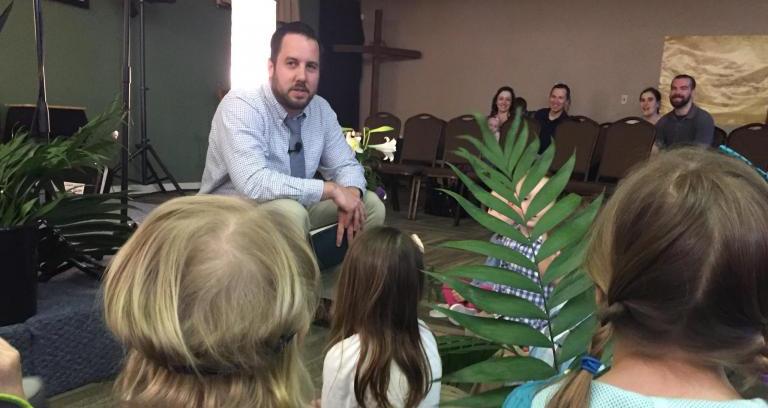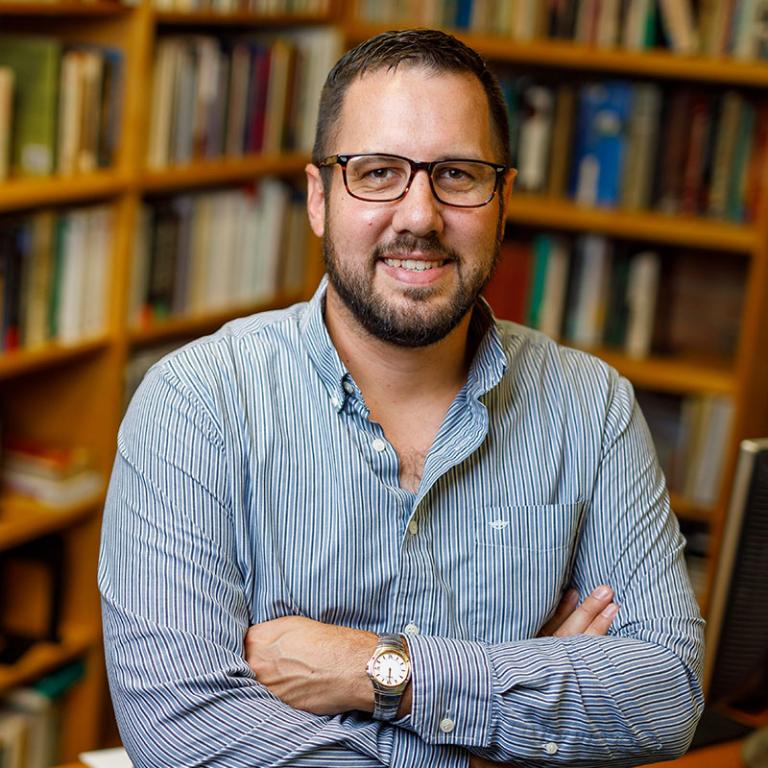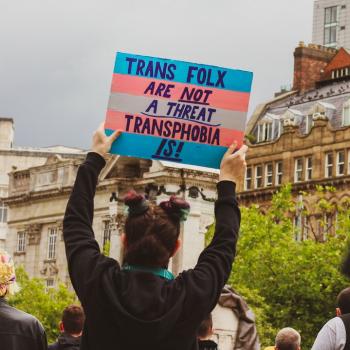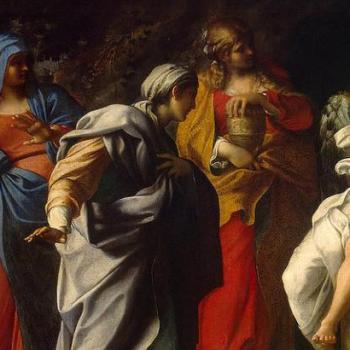In the winter of 1995, a group of homeless families in Philadelphia took a dramatic action. They broke into the abandoned St. Edward’s Catholic Church to seek shelter from the cold.

One of the organizers, Liz Theoharis, describes their action this way in her book Always with Us?:
We broke the locks, moved in, and posted passages from the Bible on the walls. . . . We hung posters asking, “Why do we worship with a homeless man on Sunday and ignore one on Monday?” When asked by nine Catholic priests from the archdiocese to leave, we refused, stating, “We talked to God, and God doesn’t want any more homeless families. All are welcome to stay in God’s house.” And when we were threatened with eviction, we urged supporters to come witness with us at the church, declaring, “Jesus is being evicted from a church in North Philadelphia!” (1)
Soon this once-abandoned church became, quite literally, a house for the poor. Theoharis continues:
Black, white, and Latino families arranged the pews for their living and sleeping quarters. Confessionals became closets. The altar held basic necessities for the residents. The youngest resident was 4 months old, the oldest in his 90s. While it was about 40 homeless men, women, and children who moved into St. Edward’s Church, those numbers doubled and tripled in the ensuing weeks. Neighbors from nearby blocks and distant suburbs showed up with donations of food, clothing, toys, and space heaters. From the sanctuary of St. Edward’s each day, children left to attend school, many adults went to work, and others continued to organize in the community. Every Sunday we held interfaith prayer services. Although the majority of the people living in St. Ed’s were Christian, the church takeover also had Muslim, Jewish, Hindu, Buddhist, and other residents and supporters. . . .
Many of the people who moved into St. Edward’s had been living at Tent City, where over forty homeless families inhabited tents, shacks, and cardboard boxes the previous summer. . . . Tent City became a community and church much like the first Christian communities. There, homeless families of various races lived together, sharing donated toys, clothing, food, and toiletries. One disabled veteran was dropped off at the lot by an ambulance from the VA hospital because he had nowhere else to call home. A sixteen-month-old boy took his first steps among the rocks, rubble, and garbage. . . . Just as in Deut. 15:4 and Acts 4:34, there was no needy person there. When families were evicted and moved to Tent City, they would present their food stamps to the community. When someone needed to go to an appointment, families would volunteer to do childcare and pool their money to pay for bus fare. When it was hot, people in the surrounding neighborhood would drop off water, juice, and sometimes popsicles for the kids. (1, 2–3)
The story of Mary anointing Jesus’s feet in Bethany ends with Jesus rebuking Judas with the oft-quoted line, “You will always have the poor among you, but you will not always have me” (John 12:8).
This line has often been used to suggest that Christians should focus on Jesus rather than issues of poverty since, after all, “you will always have the poor among you.”
A friend of mine, Johannine scholar Lindsey Mosher Trozzo, writes about this line:
I for one have heard this phrase used to justify apathy or inaction in the face of poverty, to account for outrageous expenditures in luxurious church buildings, to criticize movements that work for systemic change.
If Jesus says, “You always have the poor with you, but you do not always have me,”—so the argument goes—we should attend to spiritual needs over, above, or instead of tangible needs.
The self-described “Christ-worshipping agnostic” Kurt Vonnegut once wrote about how this line was used during his upbringing in Indiana:
Whenever anybody out that way began to worry a lot about the poor people when I was young, some eminently respectable Hoosier, possibly an uncle or an aunt, would say that Jesus himself had given up on doing much about the poor. He or she would paraphrase John twelve, Verse eight: “The poor people are hopeless. We’ll always be stuck with them.”
Despite the fact that eminently respectable Christians—even Hoosiers—have used this line to minimize the importance of the poor, there’s a problem with interpreting it this way: it can’t possibly by what Jesus means. To see why, we need to go a bit deeper into the details of the story.
To get the context for the story, we need to back up to chapter 11. There we’re introduced to a sick man named Lazarus who lives with his sisters, Mary and Martha, in a town just outside Jerusalem called Bethany.
To make sure we connect the dots, John goes out of his way in verse 2 to tell us that “this is the Mary who later poured the expensive perfume on the Lord’s feet and wiped them with her hair.”
Mary and Martha send word to Jesus that his friend Lazarus is sick. When Jesus hears this news, he waits a few days and then decides to head down to Bethany in Judea.
His disciples try to dissuade him from going. In verse 8 they object, “Rabbi, only a few days ago the people in Judea were trying to stone you. Are you going there again?”
When Jesus insists on returning to Judea, even knowing the fate that awaits him there, the disciple Thomas says to the other disciples with perhaps a twinge of gallows humor: “Let’s go, too—and die with Jesus” (v. 16).
When the arrive at Bethany, they are told that Lazarus has already died and been buried for four days. When Martha meets Jesus, she cries, “Lord, if only you had been here, my brother would not have died” (v. 21). When Mary meets Jesus at the tomb, she too cries out, “Lord, if only you had been here, my brother would not have died” (v. 32).
But then Jesus does the miraculous. Filled with anger at the death of Lazarus and the suffering it’s caused, he orders tomb to be opened and shouts into it, “Lazarus, come out!” (v. 43). And Lazarus comes out of the tomb.
So now Jesus, who already had threats on his life, has just returned to Judea and performed a miraculous sign that he knows will get attention. And, sure enough, the high council meets in Jerusalem to discuss what to do with Jesus and a plot to kill Jesus is hatched.
Knowing that this has happened, Jesus stops his public ministry and retreats to the desert to await his final entry to Jerusalem where he will confront the leaders, be arrested, and ultimately be crucified.
But on his way in to Jerusalem he stops again in Bethany to see his friends. Martha serves a dinner in Jesus’s honor, and the recently revived Lazarus, among others, eats with him.
Then Mary enters.
She is not only overcome with gratitude for what Jesus has done for her family by giving them their brother back. As a true disciple of Jesus, she also knows the fate that awaits him in Jerusalem. And so she pours out expensive perfume on Jesus’s feet to anoint him for his burial.
Mary has a keen appreciation for the unique moment they’re in—the moment between Jesus’s glorious raising of Lazarus and his humiliating and excruciating death. And so she acts in a way that’s attentive and appreciative of the moment.
Judas, however, can see none of that. As the dishonest treasurer of the group, he sees everything through the prism of money. He’s incensed by Mary’s extravagant act of devotion, which to him just seems like a waste of a valuable commodity. And so he blurts out his initial reaction to what Mary has done: “That perfume was worth a year’s wages” (12:5).
Immediately realizing that his object may be in bad taste, he tries to add a virtuous spin on it: “It should have been sold and the money given to the poor” (v. 5).
Jesus knows that the reason Judas offers for his protest is just a cover for his own selfishness. But instead of embarrassing Judas by calling him out on his greed and hypocrisy in this company, he turns Judas’s objection into an opening.
The problem with our common reading of Jesus’s quote about the poor is that it assumes Jesus is a middle-class American white guy talking to his middle-class American buddies. In that context, Jesus seems to be talking about charity.
There are always some poor people out there, Judas, if you want to sell your expensive stuff and tithe a little to the local soup kitchen. But don’t forget that what really matters isn’t the poor, who will always be around, but me, who you can only serve for a limited time.
But when we move this dinner conversation out of our imagined comfortable, middle-class banquet hall and into its original setting, it takes on a different ring.
We’re told that this dinner took place in a town called Bethany. Any time there’s a town in the Bible that begins with “Bet” or “Beth,” its name is from the Hebrew for “house.” And the second part of the name will tell us what kind of house it is.
So, the town Jesus was born in is Beth-lehem, or “house of bread.” The town that shows up frequently in the Old Testament and for which our denominational college is named is called Beth-el, or “house of God.” Another town that shows up in the New Testament is called Beth-phage, or “house of unripe figs.”
And this story takes place in Beth-any, which means “house of the poor” or “house of affliction.” In other words, the town of Bethany was an ancient Tent City or poor-house. According to New Testament scholar Reta Halteman Finger, it was a town where Jerusalem sent their poor and sick who were considered too unclean to reside in Jerusalem, the city of the Temple.
Perhaps this is why Mary and Martha lived there with their brother, Lazarus, who himself had been deathly ill for some time. Indeed, the Gospel of Mark provides the added detail that this meal in Jesus’s honor was held in the home of Simon the leper (Mark 14:3–10).
In this context, Jesus isn’t talking about charity; he’s talking about solidarity. He’s inviting his disciples into life together with the poor and for the poor.
Imagine this dinner as taking place in the middle of the occupied St. Edward’s Catholic Church in Northern Philadelphia.
As the homeless gather around for a meal in Jesus’s honor, one woman—whose brother Jesus has recently revived after an overdose—lavishly pours out her most valuable possession, a bottle of perfume, on his feet.
In the midst of this tender act of devotion—as she’s wiping his feet with her hair and as the fragrance is filling the cathedral for everyone there to experience—one of the honored guests, a disciple traveling with Jesus, blurts out: “Hey, what are you doing, lady? Don’t you know how much that stuff’s worth? That could have been sold and the money given to the poor!”
As he says the word “poor,” the room goes quiet. Everyone is staring at Jesus. How will he respond to this insulting outburst by his friend?
Jesus’s immediate concern is for the dignity of the woman. “Leave her alone!” he rebukes his disciple. “She did this in preparation for my burial.”
Implied in Jesus’s rebuke is that she is the true disciple.
She, unlike you, Judas, realizes what I am about to suffer. All you care about is money.
But Jesus doesn’t say this. Instead, he turns Judas’s pretext into an invitation:
Judas, look around you, my friend. As Mary’s action indicates, I am about to be taken from you. You won’t have me with you for long. But look into these beautiful faces who have invited us here today. These beautiful, poor, homeless people are my precious, beloved people. These people are me. And they aren’t going anywhere. No, they are here among you always.
Mary has just demonstrated her solidarity with me in my time of trouble by lavishly pouring out her gift on my feet. And even though I’m going away soon, you will never cease to have the opportunity to demonstrate your solidarity with the poor by lavishly pouring out your gifts on their feet.
You will always have the poor among you, but you will not always have me. And so I tell you, my friend, that whatever you do for the least of them, you do unto me.
Jesus was among the poor in his day, and we should expect to find him there in our day too, as Theoharis found in Philadelphia. As she describes it,
A miracle took place at the Tent City—a miracles, that is, if we believe that feeding everyone is impossible without a miracle. Perhaps it was the sharing of what the families brought with them; perhaps it was the donations from those who had more than enough—including local religious congregations—in the surrounding city and suburbs; and perhaps it was God’s work of creating something out of nothing. While the families who moved there had very little, somehow food and other necessities were abundant at Tent City and during the St. Ed’s takeover. In fact, not only was everyone fed (and housed, for that matter)—there were often too many donated clothes, too much food, and plenty of all the basic necessities.
[We] began distributing the extra food, clothing, and toys to the surrounding neighborhood. Families went out each day with secondhand baby strollers full of donations and distributed them because people in the neighborhood were also poor. Not only were we able to feed the . . . families who were living at Tent City and the church, but hundreds of families in the poorest neighborhood in Philadelphia were fed with the surplus. As the months went on, many religious congregations came to witness, pray, worship, help out, and share what they had. People heard the good news that there was a place where everyone was fed—and more poor families came, and more church people came, and they came, and they came. All were amazed at the abundance.” (3–4)












